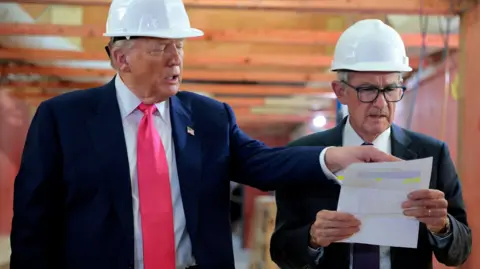New York business correspondent
 Chip Somodevilla/ Getty Images
Chip Somodevilla/ Getty ImagesDonald Trump says he’s sacking Federal Reserve governor Lisa Cook.
She says she’s not going anywhere – and is threatening legal action.
No one quite knows how this will unfold, or whether it could end up in the US Supreme Court.
What’s clear is that it’s highly unusual – and it’s raising serious questions about the independence of America’s central bank.
Why Trump is angry with the Fed
For months, the US president has been piling pressure on the Federal Reserve, demanding interest rate cuts to give the US economy a boost and make it cheaper for the government to borrow.
He’s repeatedly taken aim at Fed chair Jay Powell, calling him everything from “too late” to a “numbskull”.
It’s dramatic – but not entirely new. Presidential spats with the Fed go back decades. In the 1960s, President Lyndon Johnson famously shoved his Fed chair against a wall during an argument about rates.
What’s different now is that Trump isn’t just attacking Powell – he wants to shake up the entire Fed board and replace it with people who share his political outlook. That is what has got economists and investors on edge.
A quick reminder about the Fed
The Federal Reserve – or just “the Fed” – has been around since 1913.
Since the late 1970s, it has had two main goals: to keep prices stable and to help as many Americans as possible find work.
Crucially, it’s independent. That means it can raise or lower interest rates without needing approval from Congress or the president – even if that upsets politicians.
As economist Claudia Sahm puts it, the Fed’s independence exists for moments like this, when political leaders want policies like higher tariffs that might lower growth and raise inflation.
Why independence matters
Letting politics steer monetary policy can be risky.
Cutting interest rates might feel good at first – a kind of economic sugar rush.
But over time, it can lead to rising inflation, market instability, and higher costs for borrowers.
In 2010, then Fed chair Ben Bernanke warned that political interference could create damaging “boom and bust” cycles and make inflation harder to control.
And it’s not just a domestic issue.
Global investors rely on the Fed and US Treasury bonds as a financial safe haven.
If they start to doubt the Fed’s credibility, borrowing costs for the US government could rise – and that would have knock-on effects around the world since they are used to set the price of assets around the world.
What happens next?
So far, financial markets seem to be taking Trump’s latest threats in their stride.
But that could change quickly.
The Fed’s ability to act independently has long been seen as a cornerstone of economic stability in the US.
The fear now is that this norm – like many others – could be at risk of being swept aside.


